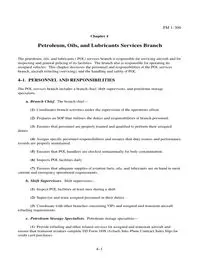
ch 4 PDF
Preview ch 4
FM 1–300 4–1 Chapter 4 Petroleum, Oils, and Lubricants Services Branch The petroleum, oils, and lubricants ( POL) services branch is responsible for servicing aircraft and for inspecting and general policing of its facilities. The branch also is responsible for operating its assigned vehicles. This chapter discusses the personnel and responsibilities of the POL services branch, aircraft refueling (servicing), and the handling and safety of POL. 4–1. PERSONNEL AND RESPONSIBILITIES The POL services branch includes a branch chief, shift supervisors, and petroleum storage specialists. a. Branch Chief. The branch chief— (1) Coordinates branch activities under the supervision of the operations officer. (2) Prepares an SOP that outlines the duties and responsibilities of branch personnel. (3) Ensures that personnel are properly trained and qualified to perform their assigned duties. (4) Assigns specific personnel responsibilities and ensures that duty rosters and performance records are properly maintained. (5) Ensures that POL handlers are checked semiannually for body contamination. (6) Inspects POL facilities daily. (7) Ensures that adequate supplies of aviation fuels, oils, and lubricants are on hand to meet current and emergency operational requirements. b. Shift Supervisors. Shift supervisors— (1) Inspect POL facilities at least once during a shift. (2) Supervise and train assigned personnel in their duties. (3) Coordinate with other branches concerning VIPs and assigned and transient aircraft refueling requirements. c. Petroleum Storage Specialists. Petroleum storage specialists— (1) Provide refueling and other related services for assigned and transient aircraft and ensure that transient aviators complete DD Form 1898 (Avfuels Into–Plane Contract Sales Slip) for credit card purchases. FM 1–300 4–2 (2) Receive, store, and inspect all petroleum products delivered to the storage area. (3) Perform operator maintenance on lines, tanks, pumps, and valves in the POL storage area. (4) Use the appropriate safety equipment specified in FM 10–68. 4–2. AIRCRAFT REFUELING (SERVICING) Normally, refuelers (refueler vehicles) are used to refuel aircraft on the flight line. They should be used when it is more practical to take the fuel to the aircraft than to bring the aircraft to the fuel. Only in unusual circumstances would a refueler be used in rapid refueling because of the inherent dangers of such an operation. FM 10–68 discusses the operating procedures to follow in such a case. a. Driver Training. (1) The drivers (operators) of refuelers may not have received formal training in the specialized field of aircraft refueling. The commander should establish and maintain an operator training program for these refueler drivers. The drivers should be thoroughly trained in the step– by–step procedures in FM 10–68. (2) Any accident involving fuel, an aircraft, or a refueler may result in fire. Only drivers who have completed the appropriate training and demonstrated their ability to refuel aircraft properly should be assigned to aircraft refueling operations. Driver qualification on all appropriate vehicles used by the POL services branch should be noted on— ! DA Form 348 (Equipment Operator=s Qualification Record (Except Aircraft)) . ! OF 346 (US Government Motor Vehicle Operator=s Identification Card). b. Preoperational Checks. Two types of preoperational checks are performed on refueling vehicles. One type is the preoperational check on the vehicle as a vehicle; for example, checking the inflation of the tires or the coolant level in the radiator. Checks of this type are outlined in the technical manual for the vehicle. The other type of preoperational check is on the refueling portion of the vehicle. FM 10–68 contains information on these checks. (1) Daily. (a) The driver of the tank truck will check the condition of the truck's electrical system before operating the truck. (b) The driver will perform the aqua glow test on the fuel being dispensed. He should maintain a log noting the tank and pump unit from which the fuel was tested and the results of the test. (2) Quarterly. Personnel should check the fueling system of the refueler according to FM 10–68. The maintenance check also should be done immediately when a nozzle strainer or a lab report on a fuel sample indicates contamination or when filter–separator elements are installed. FM 1–300 4–3 c. Personnel Refueling Requirements. Three persons should be present during the hot refueling of an aircraft. One person operates the fuel nozzle, the second remains at the emergency fuel shutoff valve, and the third mans a suitable fire extinguisher. The third person stands outside the main rotor disk of the aircraft at a point where he can see both the pilot at the controls and the refueler with the nozzle. This person may be from the forward arming and refueling point (FARP) or one of the aircraft crewmembers. In a combat situation, mission, enemy, terrain, troops, and time available (METT–T) may override the availability of a third person to man the fire extinguisher. Refueling personnel will not have matches, lighters, or other materials in their possession that could produce a spark. 4–3. POL HANDLING AND SAFETY The handling of petroleum products presents many hazards. However, both bulk and packaged products can be safely handled if personnel understand their characteristics and take precautions. During the receipt, storage, or issue of flammable and combustible petroleum products, personnel must know and observe safety precautions. Table 4–1 shows the safety rules for transferring and storing POL. Table 4–1. Safety rules for transferring and storing POL RULES REMARKS Bond and ground equipment. For all petroleum operations, always bond and ground equipment. Avoid overhead filling. If you cannot avoid overhead filling, put the end of the filling line inside the tank so that the fuel will be disturbed as little as possible. Use walkways. Always use walkways to cross tank firewalls. Ventilate and clean vehicles and containers. Collapsible tanks, railway tank cars, and tank vehicles must be cleaned and ventilated as prescribed in FM 10–20. Observe safety rules when fueling aircraft. Observe all safety precautions in FM 10–68. Observe safety rules when loading or transferring POL products. Observe all safety precautions in FM 10–71.
